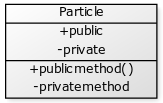Class design
Please open notebook rsepython-s4r6.ipynb
The concepts we have introduced are common between different object oriented languages.
Thus, when we design our program using these concepts, we can think at an architectural level, independent of language syntax.
In Python:
class Particle(object):
def __init__(self, position, velocity):
self.position=position
self.velocity=velocity
def move(self, delta_t):
self.position+= self.velocity*delta_t
In C++:
class Particle {
std::vector<double> position;
std::vector<double> velocity;
Particle(std::vector<double> position, std::vector<double> velocity);
void move(double delta_t);
}
In Fortran:
type particle
real :: position
real :: velocity
contains
procedure :: init
procedure :: move
end type particle
UML
UML is a conventional diagrammatic notation used to describe “class structures” and other higher level aspects of software design.
Computer scientists get worked up about formal correctness of UML diagrams and learning the conventions precisely.
Working programmers can still benefit from using UML to describe their designs.
YUML
We can see a YUML model for a Particle class with position and velocity data and a move() method using
the YUML online UML drawing tool (example).
http://yuml.me/diagram/boring/class/[Particle position;velocity move%28%29]
Here’s how we can use Python code to get an image back from YUML:
import requests
from IPython.display import Image
def yuml(model):
result = requests.get("http://yuml.me/diagram/boring/class/" + model)
return Image(result.content)
yuml("[Particle|position;velocity|move()]")

The representation of the Particle class defined above in UML is done with a box with three sections. The name of the class goes on the top, then the name of the member variables in the middle, and the name of the methods on the bottom. We will see later why this is useful.
Information Hiding
Sometimes, our design for a program would be broken if users start messing around with variables we don’t want them to change.
Robust class design requires consideration of which subroutines are intended for users to use, and which are internal.
Languages provide features to implement this: access control.
In python, we use leading underscores to control whether member variables and methods can be accessed from outside the class:
- single leading underscore (_) is used to document it’s private but people could use it if wanted (thought they shouldn’t);
- double leading underscore (__) raises errors if called.
class MyClass(object):
def __init__(self):
self.__private_data=0
self._private_data=0
self.public_data=0
def __private_method(self): pass
def _private_method(self): pass
def public_method(self): pass
def called_inside(self):
self.__private_method()
self._private_method()
self.__private_data=1
self._private_data=1
MyClass().called_inside()
MyClass()._private_method() # Works, but forbidden by convention
MyClass().public_method() # OK
print(MyClass()._private_data)
0
print(MyClass().public_data)
0
MyClass().__private_method() # Generates error
—————————————————————————
AttributeError Traceback (most recent call last)
—-> 1 MyClass().__private_method() # Generates error
AttributeError: ‘MyClass’ object has no attribute ‘__private_method’
print(MyClass().__private_data) # Generates error
—————————————————————————
AttributeError Traceback (most recent call last)
—-> 1 print(MyClass().__private_data) # Generates error
AttributeError: ‘MyClass’ object has no attribute ‘__private_data’
Property accessors
Python provides a mechanism to make functions appear to be variables. This can be used if you want to change the way a class is implemented without changing the interface:
class Person(object):
def __init__(self):
self.name = "Jameel Holt"
assert(Person().name == "Jameel Holt")
becomes:
class Person(object):
def __init__(self):
self._first = "Jameel"
self._second = "Holt"
self.name = self._first + " " + self._second
def get_married(self, to):
self._second = to._second
assert(Person().name == "Jameel Holt")
Making the same external code work as before.
Note that the code behaves the same way to the outside user. The implementation detail is hidden by private variables. In languages without this feature, such as C++, it is best to always make data private, and always access data through functions:
class Person(object):
def __init__(self):
self._first = "Jameel"
self._second = "Holt"
@property
def name(self):
return self._first + " " + self._second
assert(Person().name == "Jameel Holt")
But in Python this is unnecessary because the @property capability.
Another way could be to create a member variable name which holds the full name. However, this could lead to inconsistent data. If we create a get_married function, then the name of the person won’t change!
class Person(object):
def __init__(self, first, second):
self._first = first
self._second = second
self.name = f"{self._first} {self._second}"
def get_married(self, to):
self._second = to._second
graham = Person("Graham", "Chapman")
david = Person("David", "Sherlock")
assert(graham.name == "Graham Chapman")
graham.get_married(david)
assert(graham.name == "Graham Sherlock")
—————————————————————————
AssertionError Traceback (most recent call last)
12 assert(graham.name == “Graham Chapman”)
13 graham.get_married(david)
—> 14 assert(graham.name == “Graham Sherlock”)
AssertionError:
This type of situation could makes that the object data structure gets inconsistent with itself. Making variables being out of sync with other variables. Each piece of information should only be stored in once place! In this case, name should be calculated each time it’s required as previously shown. In database design, this is called Normalisation.
UML for private/public
We prepend a +/- on public/private member variables and methods:
yuml("[Particle|+public;-private|+publicmethod();-privatemethod]")

Class Members
Class, or static members, belong to the class as a whole, and are shared between instances.
class Counted(object):
number_created=0
def __init__(self):
Counted.number_created+=1
@classmethod
def howMany(cls):
return cls.number_created
Counted.howMany() # 0
x=Counted()
Counted.howMany() # 1
z=[Counted() for x in range(5)]
Counted.howMany() # 6
6
The data is shared among all the objects instantiated from that class. Note that in __init__ we are not using self.number_created but the name of the class. The howMany function is not a method of a particular object. It’s called on the class, not on the object. This is possible by using the @classmethod decorator.